President Lincoln's Assassination
and
Death Bed Details by
Surgeon Dr. Charles Leale
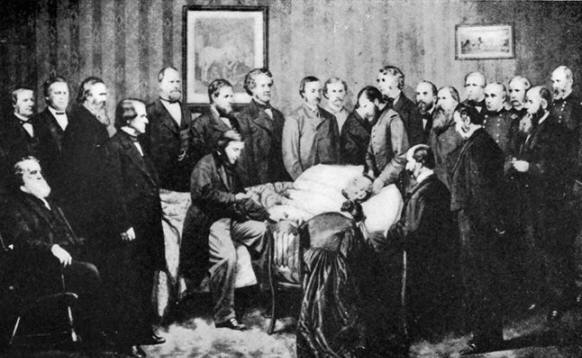
 Below
is the original handwritten four page manuscript on onionskin
paper from Dr. Charles Leale describing the events of April
14th, 1865 at Ford's Theater and the night that followed after
the assassination of the President. The letter is dated
Nov. 3, 1866 and is in response to a request by John H.
Littlefield for details of those two days. He apparently
used this information in engraving "Death Bed of Lincoln",
published in 1868 and shown above. Below
is the original handwritten four page manuscript on onionskin
paper from Dr. Charles Leale describing the events of April
14th, 1865 at Ford's Theater and the night that followed after
the assassination of the President. The letter is dated
Nov. 3, 1866 and is in response to a request by John H.
Littlefield for details of those two days. He apparently
used this information in engraving "Death Bed of Lincoln",
published in 1868 and shown above.
On the evening of
April 14, 1865, President Abraham Lincoln attended a play at Ford’s
Theatre in Washington, D.C. Sometime between ten and
ten-thirty, John Wilkes Booth - one of the most popular actors in
the country - slipped unnoticed into the Presidential box and,
standing four feet away from the President, discharged the bullet
from a single-shot derringer into the back of Lincoln’s head. The
short-barreled pocket pistol shot a round lead ball at a very low
muzzle velocity — about that, say, of today’s air guns. It was
enough, however, to render Lincoln unconscious and paralyzed.
As Booth escaped from
the theater, a young Army surgeon, Charles Leale, made his way
through the audience to Lincoln’s side. He determined that the wound
was mortal, and ordered the stricken President carried across the
street to a neighboring boarding house.
More on
Dr. Leale:
https://www.civilwarprofiles.com/charles-a-leale-the-first-doctor-to-aid-lincoln-following-the-assassination/
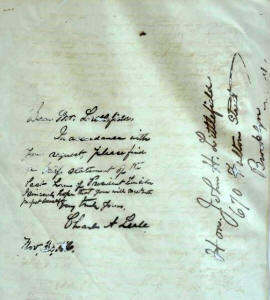 |
Hon. John H.
Littlefield,
670 Fulton Street
Brooklyn, New York
Dear Mr.
Littlefield,
In accordance
with your request, please find a brief statement
of the last hours of President Lincoln. I
sincerely hope that you will meet with perfect
success.
Very Truly Yours,
Charles A. Leale
November 30, 1865 |
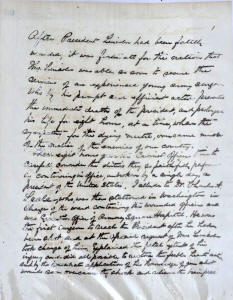
Page
1
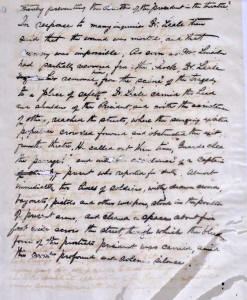
Page 2
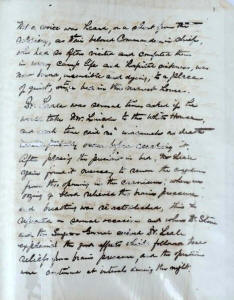
Page 3
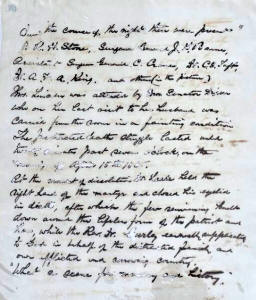
Page 4 |
Page
1
After Persident Lincoln had been fatally
wounded, it was fortunate for the nation that
Mrs. Lincoln was able so soon to secure the
services of an experienced young Army surgeon,
who by his prompt and efficient action prevented
the immediate death of the president, and
prolonged his lifge for eight hours at a time
when the sympathy for the dying martyr overcame
much of the malice of the enemies of our
country.
These eight hours gave the Cabinet Officers time
to carefully consider the duties they so
faithfully performed in continuing in office,
unbroken by a single day as president of the
United States. I allude to Dr. Charles A.
Leale, who was then stationed in Washington in
charge of the ward containing the wounded
officers and was executive officer of Armory
Square Hospital. He was the first surgeon
to reach the President after he was shot, and at
the special request of Mrs. Lincoln took charge
of him. Explained the fatal extent of his
injury and did all possible to restore the
feeble heart’s action and by the immediate
application of his knowledge of gunshot wounds
soon overcame the shock and relieved the brain
pressure,
Page 2
Thereby preventing the death of the President in
the theatre. In response to many inquiries
Dr. Leale then said that the wound was mortal,
and that recovery was impossible. As soon
as Mr. Lincoln had partially recovered from the
shock, Dr. Leale began his removal from the
scene of the tragedy to a place of safety.
Dr. Leale carried the head and shoulders of the
President, and with the assistance of others,
reached the streets, where the surging excited
populace crowded forward and obstructed the exit
from the theatre. He called out three
times, “Guards, clear the passage!” and with the
assistance of a captain present who reported for
duty. Almost immediately two lines of
soldiers, with drawn swords, bayonets, pistols
and other weapons, stood in the position of
present arms and cleared a space about five feet
wide across the street, through which the
bleeding form of the prostrate president was
carried, amid the most profound and solemn
silence.
Page 3
Not
a voice was heard, or a shout from the soldiers
as their beloved Commander in Chief who so often
had visited and comforted them in weary camp
life and hospital sickness, was now borne,
insensible and dying, to a place of quiet, to a
bed in the nearest house. Dr. Leale was
several times asked if he would take Mr. Lincoln
to the White House, and each time said “no”,
inasmuch as death would probably occur before
reaching it. After placing the President
in bed, Dr. Leale again found it necessary to
remove the coagulation from the opening in the
cranium, where oozing of blood relieved the
brain pressure and breathing was re-established,
this is repeated on several occasions and when
Dr. Stone and the Surgeon General arrived Dr.
Leale explained the good effects which followed
these reliefs from brain pressure, and the
operation was continued at intervals during the
night.
Page
4
During the course of the night there were
present Dr. R.K. Stone, Surgeon General J.K.
Barnes, Assistant Surgeon General C. Crane, Dr.
C.S. Taft, Dr. A.F.A. King and others (in the
picture). Mrs. Lincoln was attended by
Mrs. Senator Dixon who on her last visit to her
husband was carried from the room in a fainting
condition. The protracted death struggle
lasted until twenty minutes past seven o’clock
on the morning of April 15, 1865. At the
moment of dissolution Dr. Leale held the right
hand of the martyr and closed his eyelids in
death, after which the few remaining knelt down
around the lifeless form of the patriot and
hero, while the Rev. Dr. Gurley earnestly
supplicated to God in behalf of the distracted
family and our afflicted and sorrowing country.
“What a scene for memory and history.” |
Dr.
Charles Leale letter concerning General Grant
|
_small.jpg) |
605 Madison Avenue
Major General W.S. Hancock, US Army
Commander in Chief of the Military Order
of the
Loyal Legion United States of America:
I have the honor to accept the
appointment in the Medical Department of
the Loyal Legion to attend the funeral
of our late beloved and honored New York
State Commander, General U. S. Grant and
await your orders
President of the New York Count
Medical Association and Companion
|
Other
Lincoln assassination connections on this website:
On April 14, 1865, the assassin John Wilkes Booth
shot President Abraham Lincoln during a performance at Ford's
Theatre in Washington, DC. After the President passed away on
the following morning, his body was placed in a temporary coffin
covered with an American flag, and returned by hearse to the White
House, accompanied by a cavalry escort. At the White House, an
autopsy was performed by Army Surgeons
Edward Curtis and
Joseph Janvier Woodward. Also in attendance were
Surgeon
General Joseph K. Barnes and a few military officers, medical
men and friends.
Edward Curtis, M.D. was a pathologist at the Army Medical Museum. He
was commissioned assistant surgeon and saw field service with the
Army of the Potomac, and with General Sheridan in the Shenandoah
Valley. Returning to the Army museum in the fall of 1864 he
assisted with the autopsy on the body of President Lincoln, April
15, 1865
|
Below is the original handwritten four page manuscript on onionskin paper from Dr. Charles Leale describing the events of April 14th, 1865 at Ford's Theater and the night that followed after the assassination of the President. The letter is dated Nov. 3, 1866 and is in response to a request by John H. Littlefield for details of those two days. He apparently used this information in engraving "Death Bed of Lincoln", published in 1868 and shown above.






_small.jpg)